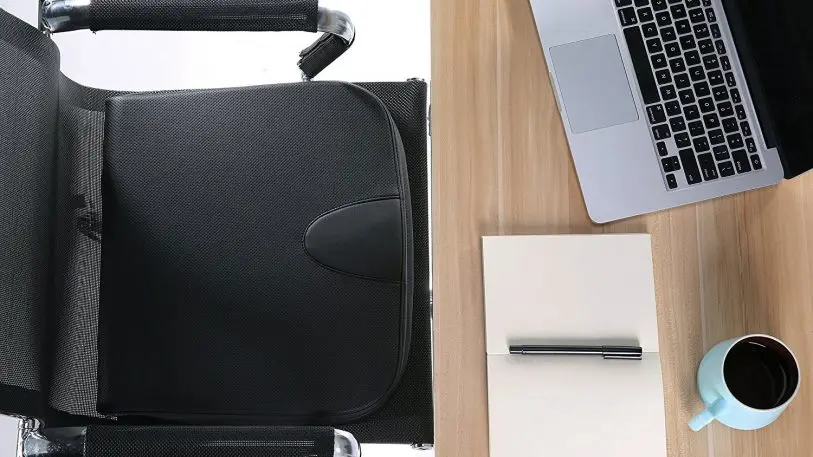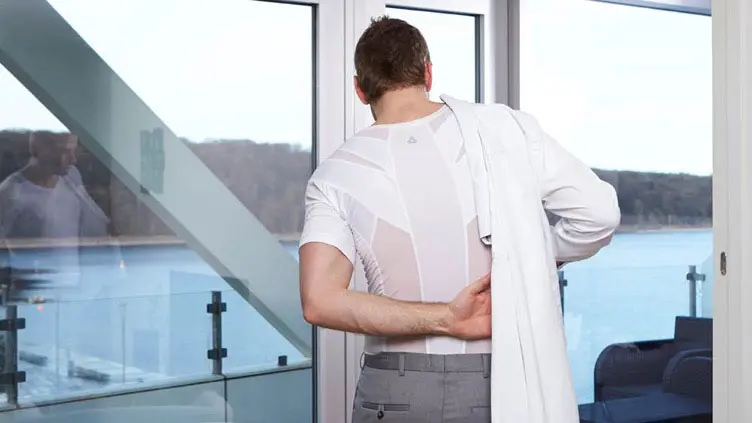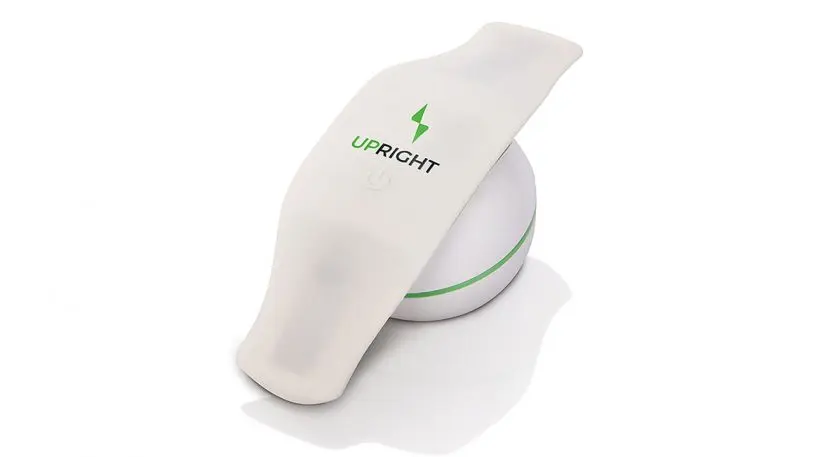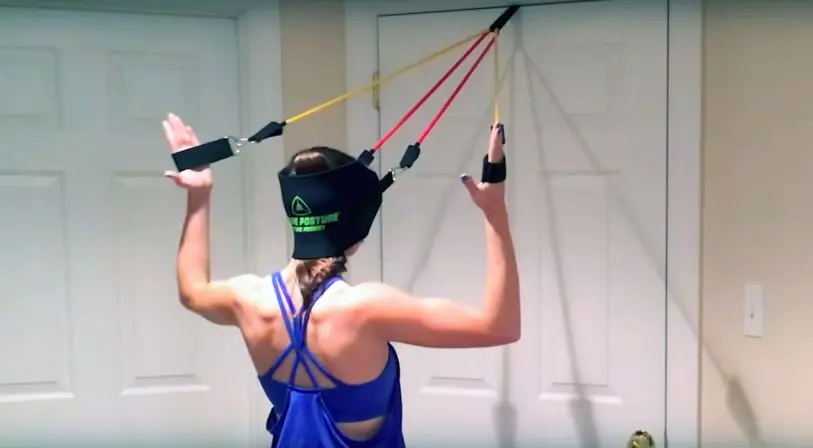The iconic human evolution chart may need to be revised. Most of us no longer walk fully upright.
“Naturally aligned human beings have become the minority in our population, a true rarity,” states the American Posture Institute, which estimates that 80% of the population suffers from posture-induced back pain. Collective treatment surpasses $1 billion a year.
It’s not surprising: Over 86% of U.S. workers sit for the entire workday, while the average time spent daily on a mobile device hovers at five hours. In total, Americans spend almost 11 hours a day on a screen, according to a recent Nielsen report. That means hunched shoulders and curved, forward-leaning “text necks.”
In the long term, this equates to a medley of potential health hazards, including fatigue, muscle tension, difficulty breathing, hampered immune functions, chronic back pain, osteoporosis, dowager humps, even depression.
“This is serious stuff,” says Dr. Paula Moore, creator of Posturevideos.com. “I’ve seen all of this … and it leads to people on a cocktail of drugs.”
It’s already severely affecting the workforce. The NIH estimates that 54% of Americans who experience lower back pain spend the majority of their workday sitting.
These frightening statistics have inspired a new cottage industry the posture-fixers.
There are dozens of wearable devices that buzz (or shock) a user upon slouching, complicated exercise systems to lengthen your spine, “get up and move” alarm apps, even clothing meant to strengthen upper-back muscles. On the wackier side there are anti-gravity chairs, “smart bras,” neck movement trackers, and something called a “massage hoodie” . For kids, there are games, pillows, and a head wearable that prevents “Gameboy Disease” (a cuter term for tech-neck) by shutting down a connected iPad if a slouch is detected.
But do any of these things actually work? And how realistic is it that we will incorporate them into our lives? To find out, I tried several gadgets in hopes of jump-starting my own posture recovery.
Here’s what I found.

This two-inch seat pillow monitors your sitting posture and slightly buzzes each time it perceives you to be slouching and leaning too far to either side. The patented fiber optical sensor technology senses vibrations and syncs with an app that delivers alerts like “You’ve been sitting on the left side. Try to center yourself on the cushion.” There’s also some positive reinforcement in the form of “Good job standing!”
https://www.youtube.com/watch?v=aqORtasgsW0
The Darma cushion sounds like one of the more effortless and non-invasive trackers, in that you don’t have to reapply any gadget daily—it waits for you at your desk. But unfortunately, it’s all too easy to cheat with this one. I was able to repeatedly droop my neck and slouch forward without ever moving my hip or bottom. In fact, at one point I realized I had been reclining forward for over an hour. The pricey sitting accessory sure is comfortable—and the app does remind you to stretch and move—but a posture perfecter it is not. The butt, it seems, does not know what the back does.

AlignMed president and founder Bill Schultz pursued his startup a decade ago after prolonged hours at the computer left him with painful herniated discs. He tried various physical therapies, pharmaceuticals, and exercises before venturing on his own mission to “simplify” the process. A wearable fitness garment, he says, works and stretches under-used muscles, strengthening the upper body—all without constant readjustment by the wearer. His products have attracted an enthusiastic following (Peyton Manning is a fan).
The AlignMed apparel is perhaps the most difficult to put on, yet delivers the most promising results of all the products I tried—for exactly that inconvenient reason. Made with an anatomic matrix of bands, panels and seams, the tops are tight to the point that you need an extra minute to get into them. That also means the idea of taking them off seems like, well, a pain. That works to its credit in that if the garments begin to constrict the wearer, he or she cannot easily rip it off, unlike its gadget competitors.
AlignMed tops are meant to retrain—not compress—muscles to improve tone and straighten backs. These are not braces. The shirts feel like a more snugly fitting rash guard, while the bras look like nursing bras, but fit like a sturdy, Olympic athlete-level sports bra. The company recommends at least two to four hours of wear, up to 12 hours. You’ll start feeling your upper body ache a little after several hours (it’s muscle fatigue, says AlignMed), but it’s in no way intolerable. Your posture will improve as the dense fabric structure makes it difficult to slouch, but don’t expect full posture perfection within the first few days. Although, after the first week, you might feel your back aching for its “corset.”

The Upright Pro is a weightless activity tracker the size of a large thumb. With a sleek white silicon mold, it looks like something out of a dystopian future—or as my husband said, “an adorable dildo for robots.” Its compact size is a big selling point, until you see its other accessories. That includes alcohol pads to clean your back and adhesives to secure it at the base of your spine. While it only takes two minutes to apply the Upright Pro, it’s still two minutes too long. It’s hard to imagine having the patience to do it every day—or each time it moves out of place.
As for its ability to detect slouching, the Upright Pro produces a near perfect score. The motion detector sends slight vibrations when it senses your upper half relaxing, can tell when you lean in an unhealthy direction, and the connected app records the amount of time you spend upright (a gold medal signifies you’re doing a good job) and suggests stretching videos. The device even managed to tell if I wasn’t standing tall when walking.
Overall, the application is a wee bit time-consuming, but if you are someone unbothered by free-floating body appendages, this one might be right for you. You start with five minutes a day and train your way to a full day’s worth of picture-perfect posture.

Active Posture Neck, Back and Total Body Exercise System by Core Prodigy ($39.95, Coreprodigy.com)
This contraption looks like a medieval torture system designed for misbehaving children. Despite its brightly colored resistance bands, the head harness resembles a masochistic posture tool. Once you overcome its peculiar setup, you realize it functions along the lines of an at-home pilates springboard. The system includes five resistance bands, two handles, and two ankle straps connected to a head harness (with two door anchors). Together, they help strengthen postural muscles and body alignment through light resistance training. A company rep suggests 10-15 minutes of use at least one to four times a week, depending on the user’s condition.
The workouts are likely the best bet to strengthen muscles and core, but the likelihood of using this system on a regular basis seems doubtful. Not to mention that the user must be properly trained as to how to use the resistance bands to full capacity and to avoid injury. Unless you plan on hiring an instructor to set up shop in your home, you’re better off just signing off for a Pilates class.

The Lumo Lift Posture Activity Tracker is a peanut-size posture coach that attaches to your clothing just below the your collarbone via a magnetic clasp. The activity tracker, in conjunction with an iOS and Android app, sends a vibration each time you slouch.
Lumo Bodytech CEO and cofounder Monisha Perkash founded in the company in 2011 after discovering that back pain was the second most common reason Americans visit the doctor (second to the common cold). She says the majority of her customers report better breathing and “a better sense of energy.”
From the very start, Lumo Lift seems to be the more tech-tailored experience. Via a two-inch tracker and connected app, it gathers information on your goals, size, and posture issues. You can set alerts to whatever time periods you want, but the recommended dosage is every 15 seconds. The idea is to train yourself to reach an hourly goal of 30 minutes of good posture and a daily goal of 10,000 steps.
On average, it detected my slouches and uneven alignments at about 80%, which is pretty high. It wasn’t as easy to “cheat” with this one. Lumo Lift is small, but it feels more intrusive than the other trackers if only for that fact that it’s placed on on the front of your shirt, and the magnetic clasp is noticeable to others. The idea of wearing such a device every day in public seems unlikely, especially when its competitors have found less noticeable areas to pin their gizmos. Word to the wise: don’t set it to go off every 15 seconds unless you want to find yourself silencing the app after a few hours of use.
The Verdict
I didn’t end up wanting to keep using any of these. They were mostly burdensome to set up, irritating after several hours, and not terribly exciting after Day One. It’s not that gadgets aren’t helpful, but that it’s all too easy to shut them off once they start annoying you.
The only item I wore with gusto were the AlignMed products, specifically the bra, which felt the most supportive in realigning my back. The shirts were as Bill Schultz had intended: Simple. Schultz says AlignMed’s sales have doubled in the last year, with 2018 predicted to reach $35 million.
What Will Really Fix Our Bad Posture
Dr. Paula Moore, a Toronto-based chiropractor and author of The Art and Science of Healthy Posture, says that posture is directly connected to a host of other health and appearance issues.

“There’s no quick fix for good posture,” says Moore, “because good posture is a habit.” On this Schultz agrees. “Very few people take an active role in their fitness,” he says. To Schultz, posture is as important as nutrition. “(Good posture) has to be habitual,” he stresses, “otherwise it’s not going to do anything.”
To that end there are sadly no quick fixes. Moore recommends repetitive daily exercises with a motto of a “little and often.” This means one to two stretches for five minutes every day or taking a break from screens every 20 minutes to rest your eyes. She very rarely suggests tech-based solutions to her clients. “They are what I find to be gimmicks,” she explains. “They don’t address the underlying issue.”
The underlying issue is that people need to learn good posture habits. Sitting up straight for 10 seconds is not enough to undo years worth of poor sitting, explains Dr. Guy Bahar, aka “The Posture Doc.”
“That’s the biggest misconception of them all, because posture is a very intricate coordinated evolved human feature that involves messages from the brain, your balance and awareness, coordinated messages through your nerves etc.,” Bahar says. “It’s meant to be [automatic], something that you don’t think about.”
Bahar, a practicing chiropractor for 25 years, does not put much faith in the plethora of gadgets that nudge one into noticing posture deficiencies. It’s a temporary awareness, he explains, which “doesn’t do anything to correct the problem—the problem is you’re not conditioned to be straight… all the signaling in the world is not going to fix that.”
So while you might be able to hold an upright position for a minute, you will eventually return to a sloping position—much in the same way as if someone told you to perform a ballet move you never learned. “Having a reminder cue is not enough,” Bahar stresses. One must first build the upper body strength to support a properly aligned back.
There’s also the “novelty factor.” People buy gadgets and their awareness does indeed get triggered. But after further exposure, the novelty wears off and within several weeks, it ends up in a kitchen drawer, says Bahar. For correct long-haul posture, the most important aspect is consistency. He strongly recommends Pilates or using a roller to relax joints for just five minutes a day.
“There are no shortcuts,” says Bahar. “It’s a process and it’s going to take time.”
Recognize your brand's excellence by applying to this year's Brands That Matters Awards before the early-rate deadline, May 3.
